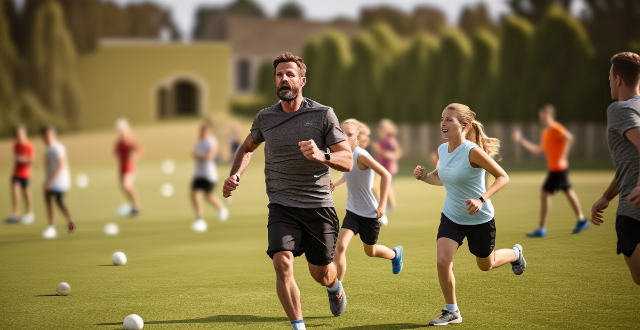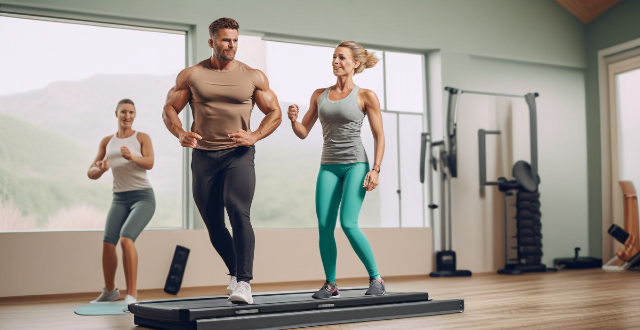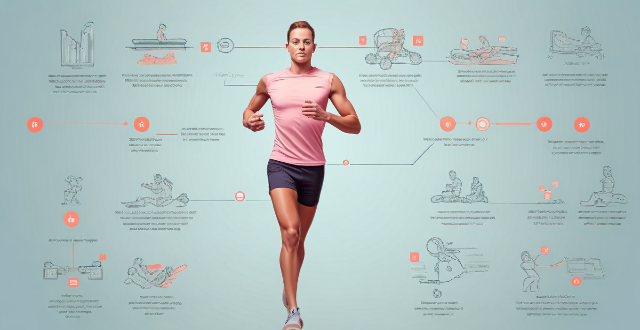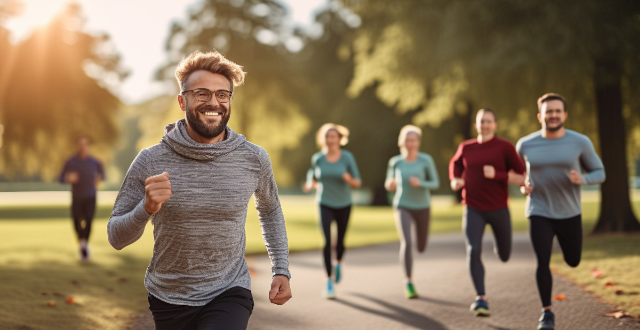Intensity Session

How long should a warm-up session typically last before engaging in sports ?
Warming up is crucial for sports to prevent injuries and prepare the body. The duration varies by sport type, fitness level, and activity intensity, generally lasting 5-15 minutes. Effective warm-ups include low-intensity activities, dynamic stretches, and sport-specific exercises.

Is it necessary to do a warm-up even for low-intensity workouts ?
A proper warm-up is crucial for any workout, including low-intensity exercises. It increases blood flow and oxygenation, raises muscle temperature, improves range of motion, primes the nervous system, reduces injury risk, and boosts performance. Even for gentle activities like walking or yoga, a warm-up enhances mental focus, gradually activates muscles, promotes consistency, supports joint health, and eases into stretching. Warm-up ideas include walking, dynamic stretching, Tai Chi movements, Pilates exercises, and deep breathing or meditation. Incorporating a warm-up before any workout is essential for maximizing performance, reducing injury risk, and enhancing overall health benefits.

How long should my gym sessions be to maximize results ?
Maximizing Gym Sessions for Optimal Results: The duration of your gym sessions can significantly impact your results. To maximize your outcomes, consider factors such as your goals, fitness level, and schedule. Recommended durations vary based on goals: muscle building requires 60-90 minutes, weight loss benefits from 30-45 minutes of HIIT or circuit training, and cardiovascular health improves with 30-60 minutes of moderate-intensity workouts. Intensity matters, with shorter high-intensity workouts being more effective for fat loss and longer moderate-intensity sessions building endurance. Listen to your body and adjust accordingly, allowing for adequate rest and recovery days to prevent injury and promote muscle growth.

How many hours per day will I be playing tennis at a training camp ?
Attending a tennis training camp can significantly improve your skills and endurance, with daily schedules typically involving 3-6 hours of intensive play. The day is structured around morning technique and strategy sessions, afternoon physical drills, and evening matches or scrimmages to apply learned concepts. Key points include the importance of adequate rest and recovery to avoid burnout and injuries. A typical day might start with a warm-up followed by technical and tactical training, then move to fitness exercises and high-intensity drills, finishing with match play and a cool down. Evening activities may include video analysis and lectures on various topics. Personal commitment levels affect the duration and intensity of training, with beginners starting with shorter sessions and advanced players engaging in more extended, intense workouts. Overall, the camp experience is designed to challenge participants while ensuring a balanced approach to their development.

How can I avoid injury after a high-intensity workout
To avoid injury after a high-intensity workout, it is important to warm up properly, stretch, use proper form, take breaks, stay hydrated, and wear appropriate clothing. These tips will help reduce the risk of injury and allow you to continue enjoying the benefits of high-intensity workouts.

How does high-intensity interval training (HIIT) affect cardiorespiratory fitness ?
High-intensity interval training (HIIT) is a form of exercise that involves short bursts of intense activity followed by periods of rest or low-intensity exercise. This type of training can improve cardiorespiratory fitness by increasing the heart rate and improving blood flow throughout the body, leading to improved muscle performance and endurance. HIIT also helps to burn calories and fat, making it an effective way to promote weight loss. Additionally, HIIT workouts can be done in a shorter amount of time than other forms of exercise, making it a great option for those who are short on time but still want to stay active and healthy. Overall, incorporating HIIT into your workout routine can provide numerous benefits for your cardiorespiratory fitness and overall health.

Is high-intensity interval training (HIIT) beneficial for reducing stress ?
The text discusses the potential benefits of High-Intensity Interval Training (HIIT) for stress reduction, including releasing endorphins, improving cardiovascular health, boosting self-confidence, enhancing focus and concentration, and providing a sense of accomplishment. It also provides tips for incorporating HIIT into a routine, such as starting slowly, choosing enjoyable activities, setting realistic goals, incorporating recovery time, and seeking professional guidance.

Is it safe for elderly people to engage in high-intensity workouts ?
The safety of high-intensity workouts for elderly people depends on various factors such as health status, fitness level, balance and coordination, recovery time, and necessary modifications and adaptations. It is essential to consult with a healthcare professional before starting any exercise program.

How often should I do aerobic exercise to see results ?
Aerobic exercise is an excellent way to improve your cardiovascular health, increase endurance, and burn calories. The frequency with which you should do aerobic exercise to see results depends on several factors, including your fitness level, goals, and overall health. If you are just starting out, it's recommended to do aerobic exercise three to four times a week for 20-30 minutes each session. As you become more comfortable with the activity, you can gradually increase the duration and frequency of your workouts. If your goal is to lose weight or improve your overall health, doing aerobic exercise three to five times a week for 30-60 minutes each session is recommended. If your goal is to increase endurance or compete in an athletic event, you may need to do aerobic exercise six or seven times a week for 45-90 minutes each session. It's important to listen to your body and avoid overtraining to prevent injury and burnout.

How often should I run during marathon preparation ?
Running is an essential component of marathon training, but how often should you run during preparation? This article will explore the optimal frequency and duration of running sessions for marathoners in their preparation phase. The importance of running cannot be overstated as it helps to build endurance, improve cardiovascular health, and increase muscle strength. The right frequency of running depends on your fitness level and the intensity of your training plan. Beginners should start with one or two runs per week and gradually increase the number as fitness improves. Experienced runners may be able to run four or five times per week without overtraining. The duration of each running session also depends on your fitness level and the intensity of your training plan. Beginners should aim for short runs at a moderate intensity while experienced runners can run longer distances at a higher intensity. Overtraining can lead to injury and burnout, so it's essential to listen to your body and give yourself enough recovery time between runs. Other factors such as terrain, weather conditions, and personal preferences can affect how often you should run during marathon preparation. It's important to adjust your training plan accordingly and avoid running in extreme conditions if possible. By following a well-structured training plan and adjusting your workouts based on personal preferences and environmental factors, you can achieve success in your marathon race!

How does exercise physiology explain the benefits of high-intensity interval training (HIIT) ?
High-intensity interval training (HIIT) is a form of exercise that involves short, intense bursts of activity followed by periods of rest or low-intensity exercise. From an exercise physiology perspective, HIIT offers numerous benefits, including increased metabolic rate, improved cardiovascular health, muscle development and endurance, favorable hormonal responses, mental health advantages, reduced injury risk, and time efficiency. These factors make HIIT a popular and effective method for achieving various fitness goals.

Is there a specific duration or intensity of exercise needed to improve immune function ?
The relationship between exercise and immune function is complex, but research suggests that regular physical activity can enhance the immune system. However, both the duration and intensity of exercise play significant roles in achieving this beneficial effect. The American Heart Association recommends at least 150 minutes of moderate-intensity aerobic activity or 75 minutes of vigorous-intensity activity per week for adults. Engaging in prolonged periods of endurance exercise can temporarily suppress immune function due to increased stress on the body. Light activities like walking or yoga can still offer immune benefits by reducing stress and promoting overall health. Regular moderate to high-intensity exercises, such as jogging, cycling, or strength training, are generally considered optimal for enhancing immune function. Adequate rest and recovery are crucial for maintaining a healthy immune system. Combining different types of exercises (aerobic, strength training, flexibility work) can provide a well-rounded approach to enhancing immune function. Staying hydrated and consuming a balanced diet rich in nutrients supports both exercise performance and immune health. Other lifestyle habits, including sleep quality, stress management, and avoidance of harmful substances, also play a vital role in supporting immune function alongside exercise.

How can I use heart rate monitoring to improve my workout routine ?
Using a heart rate monitor can significantly improve your workout routine by providing valuable insights into your body's response to exercise. Here's how you can leverage heart rate monitoring to optimize your fitness regimen: - Understanding Heart Rate Zones: Your heart rate varies depending on the intensity of your workout. By understanding these heart rate zones, you can tailor your workouts to achieve specific goals, such as fat burning, endurance building, or performance improvement. - Setting Goals Based on Heart Rate: Establish clear objectives for each workout session based on your heart rate data, such as endurance training, weight loss, or performance enhancement. - Tracking Progress: Consistently monitor your heart rate during workouts to track progress, including recording resting heart rate and assessing recovery time. - Adjusting Intensity: Modify your workout intensity based on your heart rate feedback, such as increasing intensity if you're consistently below your target heart rate zone or decreasing intensity if you're above it. - Preventing Overtraining: Use heart rate data to avoid overtraining by staying within recommended heart rate limits and recognizing signs of overexertion. - Personalizing Your Workouts: Customize your routine with heart rate in mind by incorporating different training methods and experimenting with different activities to see which ones give you the desired heart rate response.

Are there any risks associated with high-intensity workouts for seniors, especially in a group setting ?
High-intensity workouts in a group setting pose certain risks for seniors, including cardiovascular strain, musculoskeletal stress, overexertion and fatigue, and social and psychological factors. To minimize these risks, seniors should consult with a healthcare professional, start slowly and gradually increase intensity, focus on low-impact activities, stay hydrated and monitor temperature, wear appropriate footwear and clothing, listen to their body, and seek supervision from qualified instructors.

How does climate variability impact the frequency and intensity of extreme weather events like floods and hurricanes ?
Climate variability, which can be natural or human-induced, has a significant impact on the frequency and intensity of extreme weather events such as floods and hurricanes. Changes in rainfall patterns, sea level rise, and land use changes can increase the risk of flooding, while warmer ocean temperatures, atmospheric conditions, and El Niño Southern Oscillation (ENSO) can affect hurricane formation and intensity. As our planet continues to warm due to human activities, it is crucial that we take steps to mitigate the impacts of climate change and adapt to its effects on our environment and communities.

How long should my at-home workouts be to achieve maximum efficiency ?
When determining the ideal duration for at-home workouts, consider goals, fitness level, intensity, rest, time availability, and workout structure. Beginners may benefit from shorter sessions, while intermediate/advanced exercisers might need longer ones. High-intensity workouts can be shorter, while lower-intensity ones may require more time. Rest and recovery are crucial to avoid overtraining and injury. Quality over quantity is key, especially with limited time availability. Incorporating a warm-up, targeted exercises, and a cooldown/stretching period into your routine can make even shorter sessions effective.

How often should I go to the gym to see results ?
The frequency of gym visits depends on fitness goals, current fitness level, and workout intensity. Factors to consider include: 1. Fitness Goals: - Weight Loss: 3-5 days per week of moderate to high-intensity exercise. - Muscle Building: Strength training 2-3 times per week with rest days. - Endurance Training: Run or cycle 3-4 times per week. - Flexibility/Yoga: Practice daily for best results. 2. Current Fitness Level: - Beginners: Start with 2-3 days per week and gradually increase. - Intermediate: Aim for 3-4 days per week of targeted workouts. - Advanced: Up to 5-6 days per week of specialized training. 3. Intensity of Workouts: - High Intensity: Allow for more recovery time; 2-3 intense sessions per week. - Moderate Intensity: Can be done 3-5 times per week. - Low Intensity: May be done daily, but focus on active recovery. Recommended routines vary depending on the goal, such as cardiovascular exercise and strength training for weight loss, compound exercises for muscle building, long slow distance and interval training for endurance, and daily practice for flexibility and yoga. Tips for success include setting realistic goals, mixing up exercises, listening to your body, and staying consistent. Rest days are important for recovery and growth.

What is the role of exercise physiology in improving athletic performance ?
Exercise physiology, a branch of science that studies the body's responses to physical activity, is crucial for improving athletic performance. It helps in understanding the body's reaction to different exercises, training methods, and recovery strategies. By applying these principles, athletes can optimize their training programs and enhance their results in sports. The text discusses the following key points: 1. **Understanding the Body's Response to Exercise**: This includes the differences between aerobic and anaerobic energy systems and muscle fiber types, which are crucial for determining suitable exercises for various activities. 2. **Optimizing Training Programs**: Periodization, intensity, and volume are essential elements in planning effective training programs. 3. **Recovery Strategies**: Proper nutrition, sleep, and active recovery techniques aid in post-exercise recovery. 4. **Injury Prevention and Rehabilitation**: Biomechanics, strength, and flexibility training play significant roles in preventing injuries. In conclusion, exercise physiology provides valuable insights into how the body responds to various training stimuli and recovery strategies, allowing athletes to make informed decisions about their training programs. This knowledge enables them to improve performance, prevent injuries, and achieve their goals more effectively.

How does high-intensity interval training (HIIT) differ from steady-state cardio in terms of physiological adaptations ?
High-intensity interval training (HIIT) and steady-state cardio are two popular forms of aerobic exercise that differ in terms of physiological adaptations due to their unique intensity and duration characteristics. HIIT relies on both aerobic and anaerobic energy systems, while steady-state cardio primarily utilizes the aerobic energy system. HIIT promotes muscle hypertrophy and strength gains, while steady-state cardio has minimal impact on muscle hypertrophy and strength gains. HIIT leads to significant improvements in cardiovascular fitness and aerobic capacity, while steady-state cardio results in gradual improvements. HIIT increases insulin sensitivity and fat oxidation, while steady-state cardio has minimal changes in these areas. Overall, HIIT typically leads to more pronounced improvements in cardiovascular fitness, muscle hypertrophy, and metabolic adaptations compared to steady-state cardio.

What are the best stretches for cooling down after a gym session ?
After a gym session, it's crucial to gradually cool down your body. Here are the best stretches for that: hamstring, quadriceps, calf, hip flexor, and back stretches. These exercises help reduce heart rate, lower blood pressure, prevent muscle soreness, improve flexibility, and range of motion. Remember to hold each stretch for at least 30 seconds and avoid bouncing to prevent injury.

How can I make the most out of group study sessions ?
Group study sessions can be an incredibly effective way to learn and review material. By pooling knowledge, sharing insights, and engaging in collaborative learning, students can deepen their understanding of complex topics and improve their academic performance. To make the most out of group study sessions, consider the following strategies: ## Setting Clear Objectives - **Establish Goals**: Before diving into a study session, it's important to set clear objectives. Decide what topics or areas you want to cover and what you hope to achieve by the end of the session. - **Create an Agenda**: Prepare a structured agenda that outlines the topics to be discussed and the time allocated for each. This helps keep the study session focused and productive. ## Preparation is Key - **Assign Pre-reading**: Encourage all group members to do some pre-reading or pre-work before the session. This ensures everyone comes prepared with basic knowledge and questions to discuss. - **Bring Materials**: Each participant should bring relevant textbooks, notes, or any other materials that could facilitate the discussion. ## Active Participation - **Engage Actively**: Encourage all members to actively participate by asking questions, sharing insights, and contributing to discussions. - **Take Turns Teaching**: Rotate the role of "teacher" among group members. Research shows that teaching a concept to others reinforces your own understanding. ## Promote Collaboration - **Share Different Perspectives**: Each member may have a unique approach or perspective on the material. Encourage sharing these viewpoints to enrich the discussion. - **Brainstorm Together**: When confronted with challenging problems or concepts, work together to brainstorm solutions. ## Stay Focused - **Minimize Distractions**: Try to minimize distractions during the study session. Put away phones, limit side conversations, and create an environment conducive to learning. - **Stick to the Agenda**: Keep the discussion on track by referring back to the agenda and managing the time spent on each topic. ## Review and Reinforce - **Recap Key Points**: At the end of the session, summarize the key points covered. This helps reinforce learning and provides a quick reference for future studying. - **Assign Follow-up Tasks**: Assign tasks or exercises to be completed before the next session. This keeps the momentum going and ensures continued engagement with the material. ## Evaluate and Reflect - **Reflect on the Process**: Take a few minutes at the end of the session to reflect on what worked well and what could be improved. This helps fine-tune future study sessions. - **Evaluate Learning Outcomes**: Consider assessing your understanding through quizzes or short tests after a series of study sessions to evaluate the effectiveness of the group learning process.

Can I eat immediately after an intense workout session
Eating immediately after a workout is important for recovery and repair. Choose foods that provide fast-acting energy and help muscles recover, such as bananas, rice cakes, and yogurt. Add nuts or seeds for extra protein and healthy fats. Drink plenty of water during and after the workout to stay hydrated and aid recovery.

What is the cost of treatment at a sports rehabilitation center ?
The cost of treatment at a sports rehabilitation center can vary depending on several factors, such as the location, services offered, and the severity of the injury. Here's a breakdown of the potential costs you may encounter: 1. Initial Assessment Fee: This fee covers the initial evaluation by a physical therapist or sports medicine specialist. It typically ranges from $50 to $200, depending on the facility and region. 2. Physical Therapy Sessions: Each session usually lasts between 30 minutes to an hour. The cost per session can range from $75 to $200, again depending on the location and expertise of the therapist. Most insurance plans cover part of this cost, but you may have to pay a copay or coinsurance. 3. Specialized Treatments: Some centers offer specialized treatments like hydrotherapy, ultrasound therapy, or electrical stimulation. These treatments can add an additional $30 to $100 per session. 4. Equipment Rental or Purchase: If your recovery requires the use of special equipment (like crutches, knee braces, etc.), there will be an additional cost. Rental fees can vary widely, while purchasing outright might set you back anywhere from $50 to several hundred dollars. 5. Follow-up Appointments: As your recovery progresses, you might need follow-up appointments to assess your progress and adjust your treatment plan. These can cost anywhere from $50 to $150 each. 6. Total Cost: The total cost of treatment can vary significantly based on the above factors. On average, you might expect to spend anywhere from $1,000 to $5,000 for a moderate to severe injury, assuming regular sessions over several weeks or months. Remember, this is just an estimate; actual costs can be higher or lower depending on individual circumstances.

What are the best foods to eat after a strenuous exercise session
After a strenuous exercise session, your body needs energy to recover and repair itself. Carbs are the best source of energy for your muscles and help replenish glycogen stores. Good sources of carbohydrates include whole grains, fruits, and vegetables. Protein is essential for muscle growth and repair after a workout. It helps rebuild damaged muscle tissue and increase strength and endurance. Good sources of protein include lean meats, fish, eggs, and plant-based proteins like beans and lentils. Water is important to stay hydrated and aid in recovery. Drinking water also helps flush out toxins from your body and prevent cramping. Exercise can cause electrolyte imbalances, which can lead to fatigue and cramping. Consuming foods rich in electrolytes like potassium, sodium, and magnesium can help restore balance and improve performance during recovery. Healthy fats are an important part of a balanced diet, especially after a workout. They provide energy for your body and help with hormone production and inflammation regulation. Vitamins and minerals are depleted during exercise, so it's important to consume foods that are rich in these nutrients during recovery.

How does caffeine influence workout intensity and results ?
Caffeine can boost workout intensity and results by increasing energy levels, improving focus, and enhancing endurance. However, it's important to be aware of potential side effects like dehydration risks, sleep disruption, and dependency issues. Moderation and individualized consideration are key when incorporating caffeine into a fitness routine.

Is it necessary to stretch after a high-intensity workout
Topic: Stretching after a high-intensity workout Summary: The author believes that stretching is essential after a high-intensity workout for Americans. It helps to reduce muscle soreness and stiffness, improve flexibility, prevent injuries, increase blood flow, and promote recovery. Therefore, the author recommends incorporating stretching into their post-workout routine.

How often should I practice to see improvement in my golf skills ?
Golf improvement requires consistent practice, and the frequencyGolf improvement requires consistent practice, and the frequency your skill level, goals, and the frequency of your sessions depends on your skill level, goals, and availability. Assess your current skill level and set realistic goals to create a practice plan that includes both on-course and off-course activities. Beginners should aim for at least three practice sessions per week, while intermediates can do two to three and advanced players one or two. Make each session count by focusing on specific goals and tracking progress. Consistency is key, so stick to your practice plan and adjust it as needed based on your progress.

How long should my aerobic workouts be ?
Aerobic exercises, or cardio workouts, are vital for overall health and fitness. The American Heart Association recommends at least 150 minutes of moderate-intensity activity or 75 minutes of vigorous activity per week. This can be broken down into shorter sessions throughout the day. Starting slow and gradually increasing duration and intensity is advised. Mixing up activities helps prevent injury and keeps workouts interesting. Benefits include improved cardiovascular health, weight management, mood enhancement, and a stronger immune system. Always consult with a healthcare professional before starting any new exercise regimen.

Does high-intensity interval training (HIIT) have specific benefits for chronic disease prevention ?
High-intensity interval training (HIIT) offers numerous benefits for chronic disease prevention, including improved cardiovascular health, enhanced glucose control, reduced inflammation, increased muscle mass and strength, and improved mental health outcomes. To incorporate HIIT into a healthy lifestyle, start slowly, choose the right exercises, include other forms of exercise, and consult with a health professional.

How often should I check my heart rate while exercising ?
Checking your heart rate is an important part of staying healthy and fit. However, how often you should check it depends on several factors, including your age, fitness level, and overall health. Here are some guidelines to help you determine the optimal frequency for checking your heart rate during exercise: For beginners: Check your heart rate every five minutes during the first few weeks of training to get a sense of your target heart rate range and adjust accordingly as you become more comfortable with the activity. For experienced athletes: Once or twice per workout is sufficient for experienced athletes who have established a good foundation in their fitness routine. This will allow them to focus more on their form and intensity without constantly worrying about their heart rate. For older adults or those with pre-existing health conditions: Older adults or those with pre-existing health conditions may need to monitor their heart rate more frequently than younger individuals. It's recommended that they check their heart rate at least once per workout and perhaps even before and after each session to stay safe and ensure they're not overexerting themselves.